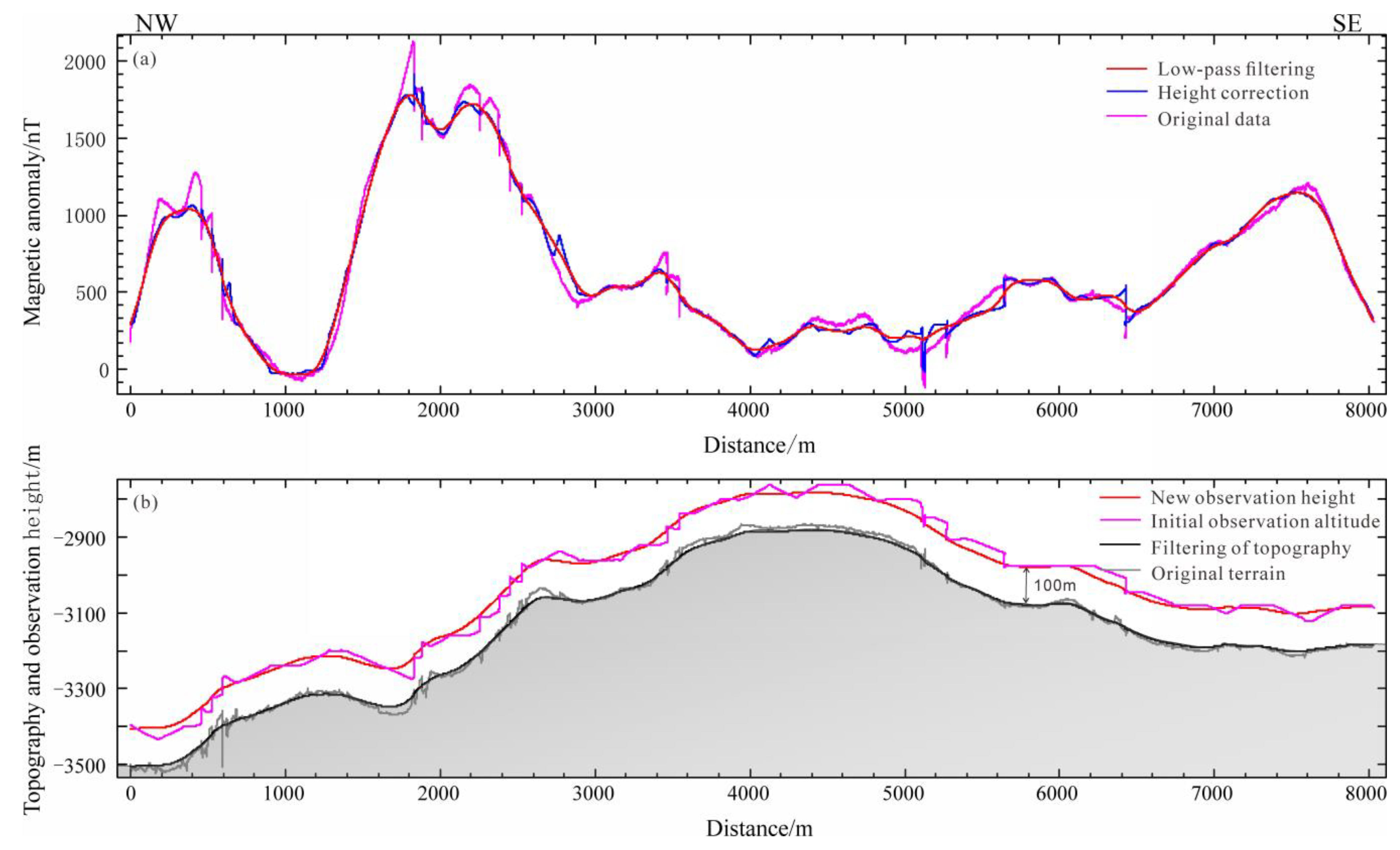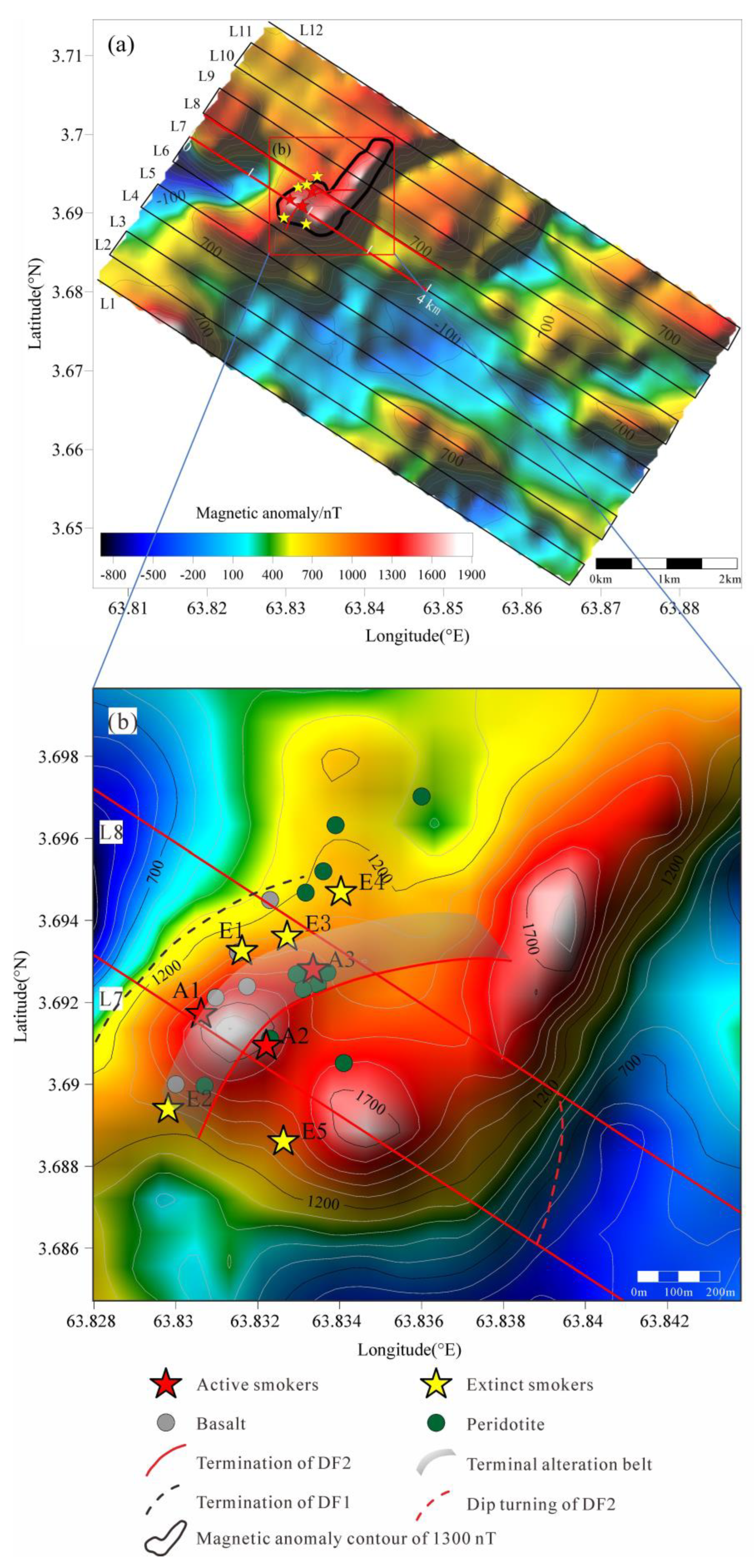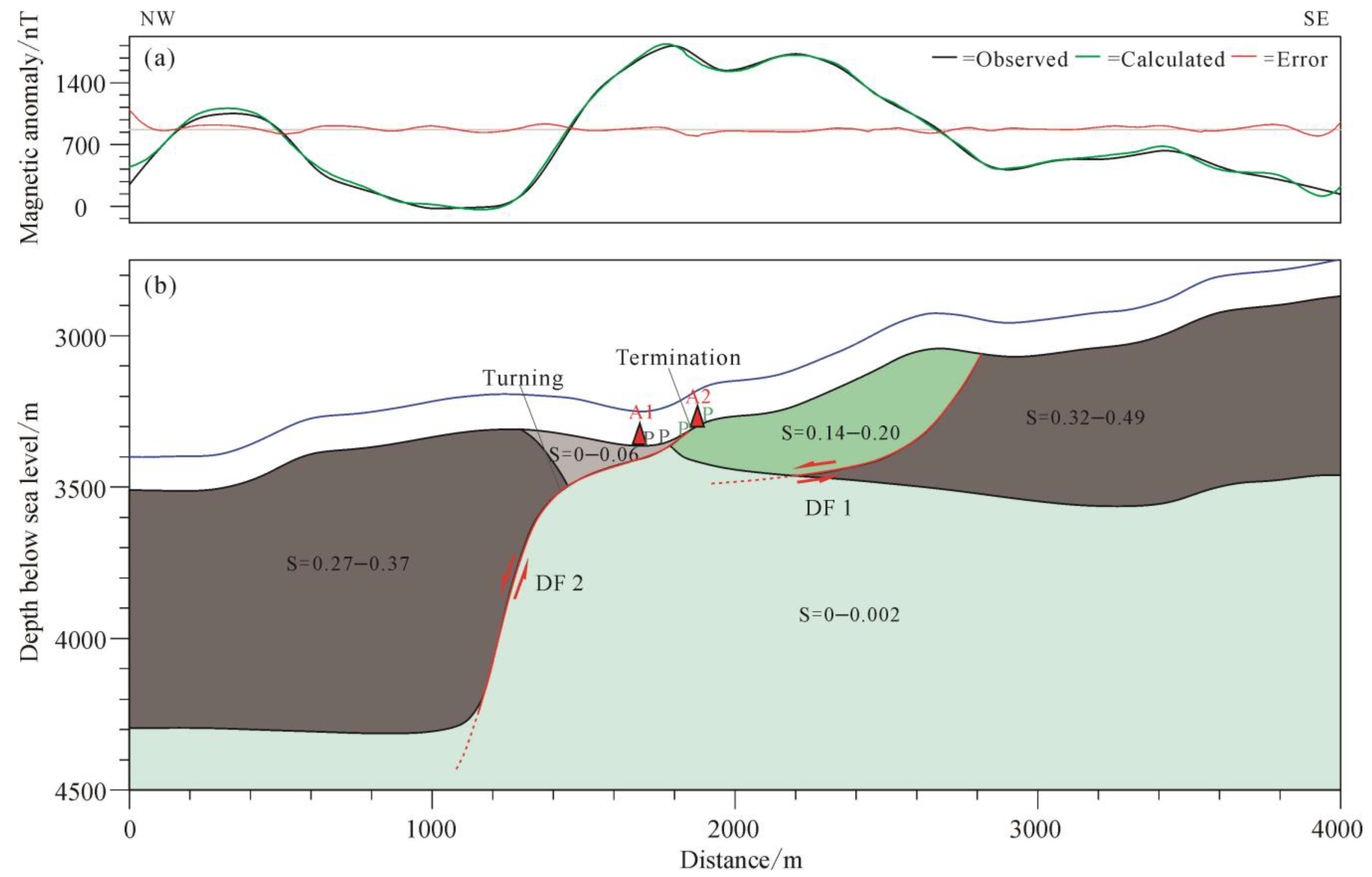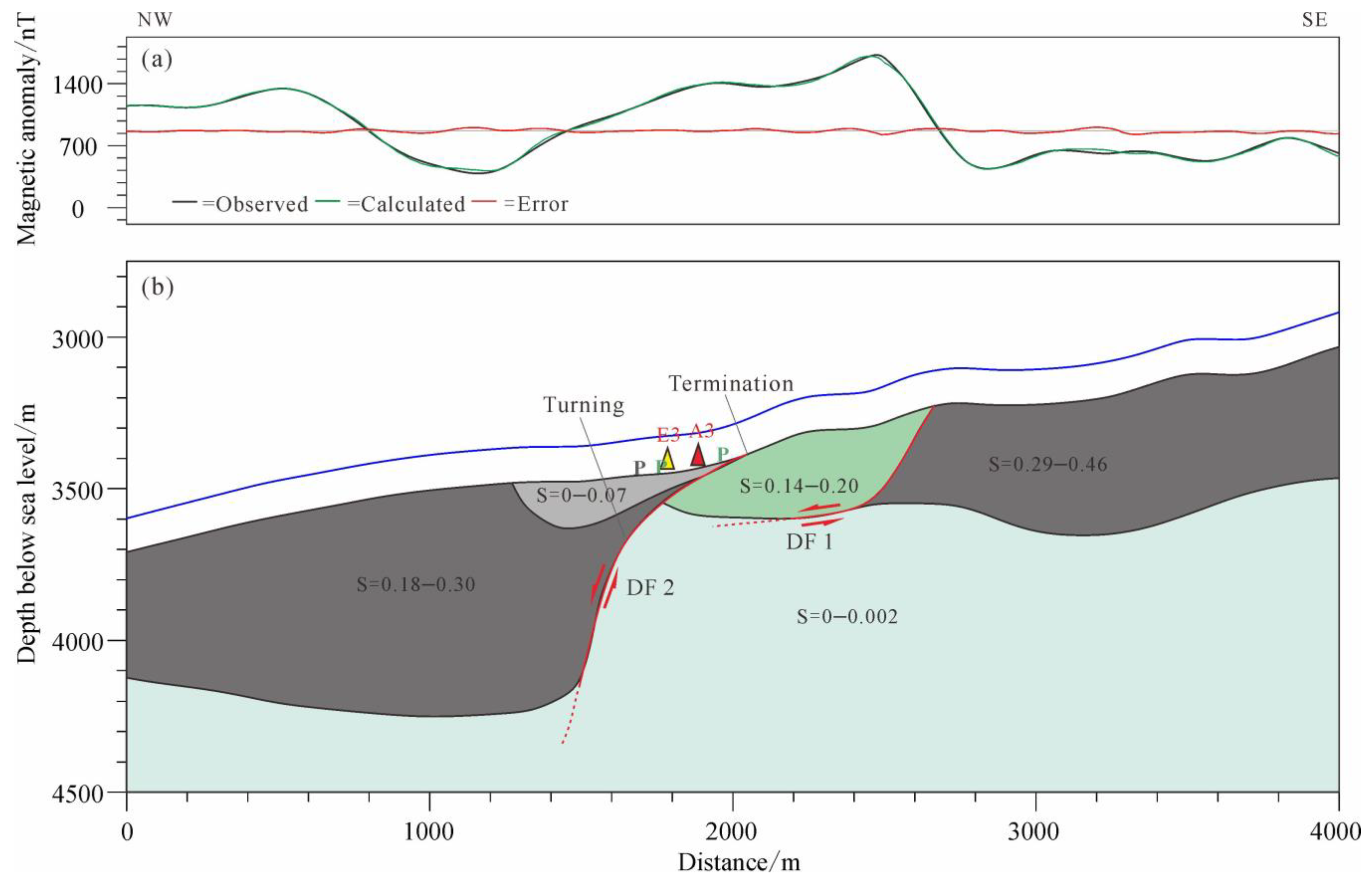Near-Bottom Magnetic Anomaly Features and Detachment Fault Morphology in Tianxiu Vent Field, Carlsberg Ridge, Northwest Indian Ocean
Abstract
1. Introduction
2. Geological Background
3. Data Collection and Processing
4. Results and Discussion
4.1. Magnetic Anomaly Features and Sources
4.2. Subsurface Magnetic Structure and Detachment Fault Morphology
5. Conclusions
Author Contributions
Funding
Institutional Review Board Statement
Informed Consent Statement
Data Availability Statement
Acknowledgments
Conflicts of Interest
References
- Corliss, J.B.; Dymond, J.; Gordon, L.I.; Edmond, J.M.; Von Herzen, R.; Ballard, R.D.; Green, K.; Williams, D.; Bainbridge, A.; Crane, K. Submarine Thermal Springs on the Galapagos Rift. Science 1979, 203, 1073–1083. [Google Scholar] [CrossRef]
- Hannington, M.D.; de Ronde, C. Sea-Floor Tectonics and Submarine Hydrothermal Systems. In One Hundredth Anniversary Volume; GeoScienceWorld: McLean, VA, USA, 2005; Volume 1905, pp. 111–141. [Google Scholar]
- Tao, C.; Li, H.; Jin, X.; Zhou, J.; Wu, T.; He, Y.; Deng, X.; Gu, C.; Zhang, G.; Liu, W. Seafloor hydrothermal activity and polymetallic sulfide exploration on the southwest Indian ridge. Chin. Sci. Bull. 2014, 59, 2266–2276. [Google Scholar] [CrossRef]
- Rona, P.A.; Hannington, M.D.; Raman, C.V.; Thompson, G.; Tivey, M.K.; Humphris, S.E.; Lalou, C.; Petersen, S. Active and Relict Sea-Floor Hydrothermal Mineralization at the Tag Hydrothermal Field, Mid-Atlantic Ridge. Econ. Geol. 1993, 88, 1989–2017. [Google Scholar] [CrossRef]
- Kent, D.V.; Gee, J. Magnetic alteration of zero-age oceanic basalt. Geology 1996, 24, 703–706. [Google Scholar] [CrossRef]
- De Ronde, C.E.J.; Hannington, M.D.; Stoffers, P.; Wright, I.C.; Ditchburn, R.G.; Reyes, A.G.; Baker, E.T.; Massoth, G.J.; Lupton, J.E.; Walker, S.L.; et al. Evolution of a Submarine Magmatic-Hydrothermal System: Brothers Volcano, Southern Kermadec Arc, New Zealand. Econ. Geol. 2005, 100, 1097–1133. [Google Scholar] [CrossRef]
- Szitkar, F.; Dyment, J.; Choi, Y.; Fouquet, Y. What causes low magnetization at basalt-hosted hydrothermal sites? Insights from inactive site Krasnov (MAR 16°38′ N). Geochem. Geophys. Geosyst. 2014, 15, 1441–1451. [Google Scholar] [CrossRef]
- Dyment, J.; Tamaki, K.; Horen, H.; Fouquet, Y.; Nakase, K.; Yamamoto, M.; Ravilly, M.; Kitazawa, M. A Positive Magnetic Anomaly at Rainbow Hydrothermal Site in Ultramafic Environment. In AGU Fall Meeting Abstracts; American Geophysical Union: Washington, DC, USA, 2005; Volume 2005, p. OS21C-08. [Google Scholar]
- Tivey, M.A.; Dyment, J. The Magnetic Signature of Hydrothermal Systems in Slow Spreading Environments. In Diversity Of Hydrothermal Systems On Slow Spreading Ocean Ridges; Rona, P.A., Devey, C.W., Dyment, J., Murton, B.J., Eds.; American Geophysical Union: Washington, DC, USA, 2010; pp. 43–66. [Google Scholar]
- Charlou, J.L.; Donval, J.P.; Konn, C.; OndréAs, H.; Fouquet, Y.; Jean-Baptiste, P.; Fourré, E. High Production and Fluxes of H2 and CH4 and Evidence of Abiotic Hydrocarbon Synthesis by Serpentinization in Ultramafic-Hosted Hydrothermal Systems on the Mid-Atlantic Ridge. Geophys. Union Geophys. Monogr. Ser. 2010, 188, 265–296. [Google Scholar]
- Kowalczyk, P. Geophysical Exploration for Submarine Massive Sulfide Deposits. In Proceedings of the OCEANS’11 MTS/IEEE KONA, Waikoloa, HI, USA, 19–22 September 2011. [Google Scholar]
- Wu, T.; Tao, C.; Liu, C.; Li, H.; Wu, Z.; Wang, S.; Chen, Q. Geomagnetic Models and Edge Recognition of Hydrothermal Sulfide Deposits at Mid-ocean Ridges. Mar. Georesour. Geotechnol. 2015, 34, 630–637. [Google Scholar] [CrossRef]
- Tivey, M.A. High-resolution magnetic surveys over the Middle Valley mounds, northern Juan de Fuca Ridge. Proc. Ocean. Drill. Program Sci. Results 1994, 139, 29–35. [Google Scholar]
- Johnson, H.P.; Karsten, J.L.; Vine, F.J.; Smith, G.C.; Schonharting, G. A low-level magnetic survey over a massive sulfide ore body in the Troodos ophiolite complex, Cyprus. Mar. Technol. Soc. J. 1982, 16, 76–80. [Google Scholar]
- Tao, C.; Wu, T.; Liu, C.; Li, H.; Zhang, J. Fault inference and boundary recognition based on near-bottom magnetic data in the Longqi hydrothermal field. Mar. Geophys. Res. 2017, 38, 17–25. [Google Scholar] [CrossRef]
- Galley, C.G.; Jamieson, J.W.; Lelièvre, P.G.; Farquharson, C.G.; Parianos, J.M. Magnetic imaging of subseafloor hydrothermal fluid circulation pathways. Sci. Adv. 2020, 6, c6844. [Google Scholar] [CrossRef] [PubMed]
- Tivey, M.A.; Rona, P.A.; Schouten, H. Reduced crustal magnetization beneath the active sulfide mound, TAG hydrothermal field, Mid-Atlantic Ridge at 26° N. Earth Planet. Sci. Lett. 1993, 115, 101–115. [Google Scholar] [CrossRef]
- Szitkar, F.; Dyment, J.; Fouquet, Y.; Honsho, C.; Horen, H. The magnetic signature of ultramafic-hosted hydrothermal sites. Geology 2014, 42, 715–718. [Google Scholar] [CrossRef]
- Caratori Tontini, F.; de Ronde, C.E.J.; Yoerger, D.; Kinsey, J.; Tivey, M. 3-D focused inversion of near-seafloor magnetic data with application to the Brothers volcano hydrothermal system, Southern Pacific Ocean, New Zealand. J. Geophys. Res. Solid Earth 2012, 117, B10102. [Google Scholar] [CrossRef]
- Han, X.; Wang, Y.; Li, X. First Ultramafic-Hosted Hydrothermal Sulfide Deposit Discovered on the Carlsberg Ridge, Northwest Indian Ocean. In Proceedings of the Third InterRidge Theoretical Insitute, Hangzhou, China, 25–27 September 2015. [Google Scholar]
- Rasmussen, R.; Pedersen, L.B. End corrections in potential field modeling. Geophys. Prospect. 1979, 27, 749–760. [Google Scholar] [CrossRef]
- Talwani, M.; Heirtzler, J.R. Computation of Magnetic Anomalies Caused by Two Dimensional Structures of Arbitary Shape. In Computers in the Mineral Industries; Stanford University Press: Redwood City, CA, USA, 1964; pp. 464–480. [Google Scholar]
- Kamesh Raju, K.A.; Chaubey, A.K.; Amarnath, D.; Mudholkar, A. Morphotectonics of the Carlsberg Ridge between 62°20′ and 66°20′ E, northwest Indian Ocean. Mar. Geol. 2008, 252, 120–128. [Google Scholar] [CrossRef]
- Han, X.; Wu, Z.; Qiu, B. Morphotectonic Characteristics of the Northern Part of the Carlsberg Ridge near the Owen Fracture Zone and the Occurrence of Oceanic Core Complex Formation. In Proceedings of the AGU Fall Meeting Abstracts, Washington, DC, USA, 25–27 December 2012; American Geophysical Union: Washington, DC, USA, 2012; Volume 2012, p. OS13B-1722. [Google Scholar]
- Chen, Y.; Han, X.; Wang, Y.; Lu, J. Precipitation of Calcite Veins in Serpentinized Harzburgite at Tianxiu Hydrothermal Field on Carlsberg Ridge (3.67° N),Northwest Indian Ocean: Implications for Fluid Circulation. J. Earth Sci. 2020, 31, 91–101. [Google Scholar] [CrossRef]
- Zhou, P.; Han, X.; Wang, Y.; Wu, X.; Zong, T.; Yu, X.; Liu, J.; Li, H.; Qiu, Z. Hydrothermal Alteration of Basalts in the Ultramafic-Associated Tianxiu Vent Field, Carlsberg Ridge. Mar. Geol. 2023; under review. [Google Scholar] [CrossRef]
- Honsho, C.; Ura, T.; Kim, K. Deep-sea magnetic vector anomalies over the Hakurei hydrothermal field and the Bayonnaise knoll caldera, Izu-Ogasawara arc, Japan. J. Geophys. Res. Solid Earth 2013, 118, 5147–5164. [Google Scholar] [CrossRef]
- Bloomer, S.; Kowalczyk, P.; Williams, J.; Wass, T.; Enmoto, K. Compensation of Magnetic data for Autonomous Underwater Vehicle Mapping Surveys. In Proceedings of the 2014 IEEE/OES Autonomous Underwater Vehicles (AUV), Oxford, MS, USA, 6–9 October 2014. [Google Scholar]
- Paterson Norman, R.; Reford Stephen, W.; Kwan Karl, C.H. Continuation of Magnetic Data between Arbitrary Surfaces: Advances and Applications. In SEG Technical Program Expanded Abstracts 1990; Society of Exploration Geophysicists: Houston, TX, USA, 1990; Volume 60, pp. 666–669. [Google Scholar]
- Lim, A.; Brönner, M.; Johansen, S.E.; Dumais, M.-A. Hydrothermal Activity at the Ultraslow-Spreading Mohns Ridge: New Insights From Near-Seafloor Magnetics. Geochem. Geophys. Geosyst. 2019, 20, 5691–5709. [Google Scholar] [CrossRef]
- Szitkar, F.; Tivey, M.A.; Kelley, D.S.; Karson, J.A.; Früh-Green, G.L.; Denny, A.R. Magnetic exploration of a low-temperature ultramafic-hosted hydrothermal site (Lost City, 30° N, MAR). Earth Planet. Sci. Lett. 2017, 461, 40–45. [Google Scholar] [CrossRef]
- Fujii, M.; Okino, K.; Sato, T.; Sato, H.; Nakamura, K. Origin of magnetic highs at ultramafic hosted hydrothermal systems: Insights from the Yokoniwa site of Central Indian Ridge. Earth Planet. Sci. Lett. 2016, 441, 26–37. [Google Scholar] [CrossRef]
- Escartín, J.; Canales, J.P. Detachments in Oceanic Lithosphere: Deformation, Magmatism, Fluid Flow, and Ecosystems. Eos Trans. Am. Geophys. Union 2011, 92, 31. [Google Scholar] [CrossRef]
- Gràcia, E.; Charlou, J.L.; Radford-Knoery, J.; Parson, L.M. Non-transform offsets along the Mid-Atlantic Ridge south of the Azores (38° N–34° N): Ultramafic exposures and hosting of hydrothermal vents. Earth Planet. Sci. Lett. 2000, 177, 89–103. [Google Scholar] [CrossRef]
- Mccaig, A.M.; Cliff, R.A.; Escartin, J.; Fallick, A.E.; Macleod, C.J. Oceanic detachment faults focus very large volumes of black smoker fluids. Geology 2007, 35, 935–938. [Google Scholar] [CrossRef]
- Buck, W.R. Flexural rotation of normal faults. Tectonics 1988, 5, 959–973. [Google Scholar] [CrossRef]





Disclaimer/Publisher’s Note: The statements, opinions and data contained in all publications are solely those of the individual author(s) and contributor(s) and not of MDPI and/or the editor(s). MDPI and/or the editor(s) disclaim responsibility for any injury to people or property resulting from any ideas, methods, instructions or products referred to in the content. |
© 2023 by the authors. Licensee MDPI, Basel, Switzerland. This article is an open access article distributed under the terms and conditions of the Creative Commons Attribution (CC BY) license (https://creativecommons.org/licenses/by/4.0/).
Share and Cite
Du, S.; Wu, Z.; Han, X.; Wang, Y.; Li, H.; Zhang, J. Near-Bottom Magnetic Anomaly Features and Detachment Fault Morphology in Tianxiu Vent Field, Carlsberg Ridge, Northwest Indian Ocean. J. Mar. Sci. Eng. 2023, 11, 918. https://doi.org/10.3390/jmse11050918
Du S, Wu Z, Han X, Wang Y, Li H, Zhang J. Near-Bottom Magnetic Anomaly Features and Detachment Fault Morphology in Tianxiu Vent Field, Carlsberg Ridge, Northwest Indian Ocean. Journal of Marine Science and Engineering. 2023; 11(5):918. https://doi.org/10.3390/jmse11050918
Chicago/Turabian StyleDu, Shuang, Zhaocai Wu, Xiqiu Han, Yejian Wang, Honglin Li, and Jialing Zhang. 2023. "Near-Bottom Magnetic Anomaly Features and Detachment Fault Morphology in Tianxiu Vent Field, Carlsberg Ridge, Northwest Indian Ocean" Journal of Marine Science and Engineering 11, no. 5: 918. https://doi.org/10.3390/jmse11050918
APA StyleDu, S., Wu, Z., Han, X., Wang, Y., Li, H., & Zhang, J. (2023). Near-Bottom Magnetic Anomaly Features and Detachment Fault Morphology in Tianxiu Vent Field, Carlsberg Ridge, Northwest Indian Ocean. Journal of Marine Science and Engineering, 11(5), 918. https://doi.org/10.3390/jmse11050918





